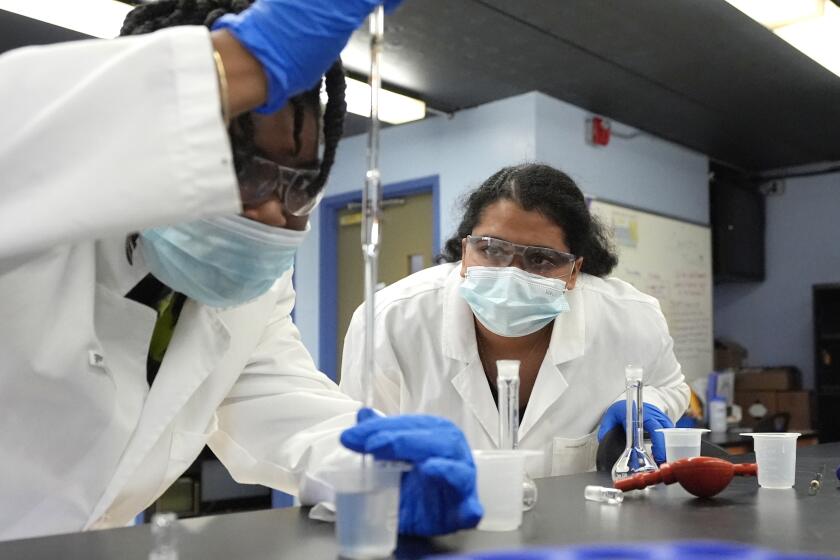Newsletter: How solar panels on farmland could help California fix its water and power crises
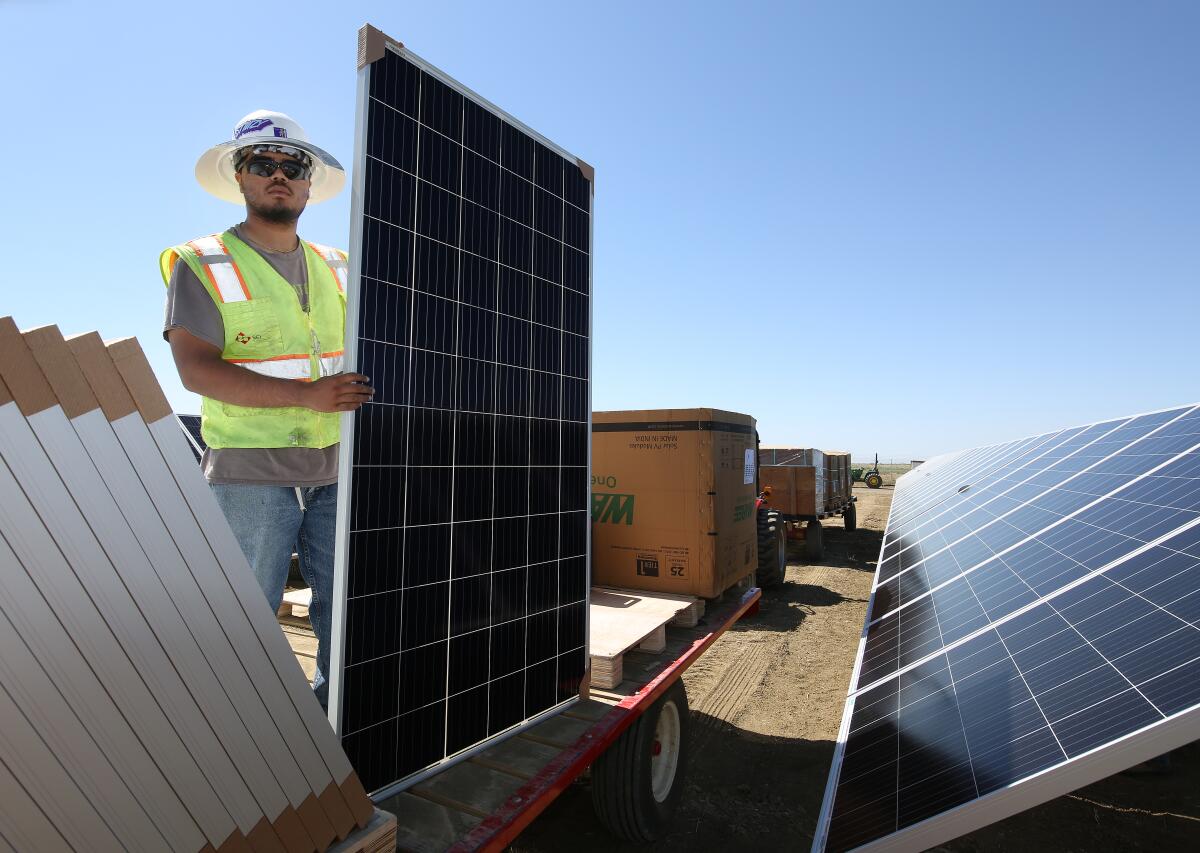
This is the July 8, 2021, edition of Boiling Point, a weekly newsletter about climate change and the environment in California and the American West. Sign up here to get it in your inbox.
To the extent most Californians are thinking about energy right now, they’re probably wondering whether the lights will stay on during the next heat wave.
It’s a reasonable fear, especially after the state’s power grid operator issued an urgent call for electricity supplies last week and warned of possible shortfalls this summer. The California Independent System Operator is seeking bids from power plants that can fire up after sundown, when solar panels stop generating but air conditioners keep humming.
Why the newfound urgency? State officials wrote that California’s ability to produce hydropower could be reduced by as much as 1,000 megawatts this summer as reservoir levels fall due to drought. At least 300 megawatts of gas-fired power won’t be available either due to “unforeseen circumstances.” And a few hundred megawatts of new energy resources that were expected to be ready to go by Aug. 1 — mostly lithium-ion batteries — could be “delayed by one to several months,” officials wrote.
They also pointed to recent heat waves across the American West as evidence California can no longer rely so heavily on electricity imports from other states. Like falling water levels at reservoirs, it’s a problem the climate crisis has worsened.
“Summer has barely begun and we have already had repeated extreme heat events creating dangerous conditions and shattering records,” leaders of the Independent System Operator, the Public Utilities Commission and the Energy Commission wrote in a joint statement. “Climate change is here and with increasing intensity.”
So the next few months could be a wild ride, with more rolling blackouts a possibility.
But the challenge of transitioning from fossil fuels to renewable energy, without sending us plunging into darkness, will extend far beyond this summer. With that in mind, let’s zoom out and look at an enormous solar project in California’s farm country that helps tell the story of the state’s energy future — and its water future, too.
I’m talking about Westlands Solar Park, which is currently being built in the heart of the San Joaquin Valley. I drove up last month, staying the night in Kettleman City, just off the 5 freeway, before heading northeast to the project site the next morning.
The place was a beehive of activity. More than 400 construction workers were keeping busy in the summer heat, many of them unloading solar panels from tractors, methodically placing them on steel racks and screwing them into place.
Here’s what it looked like, from my perspective:

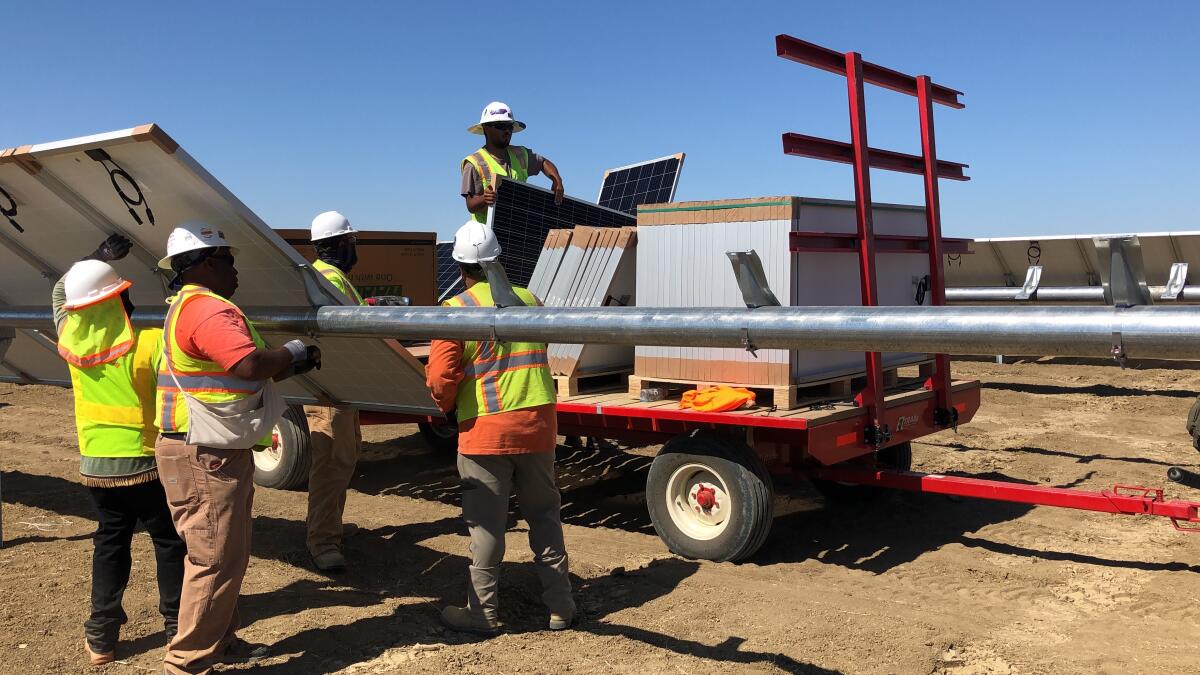
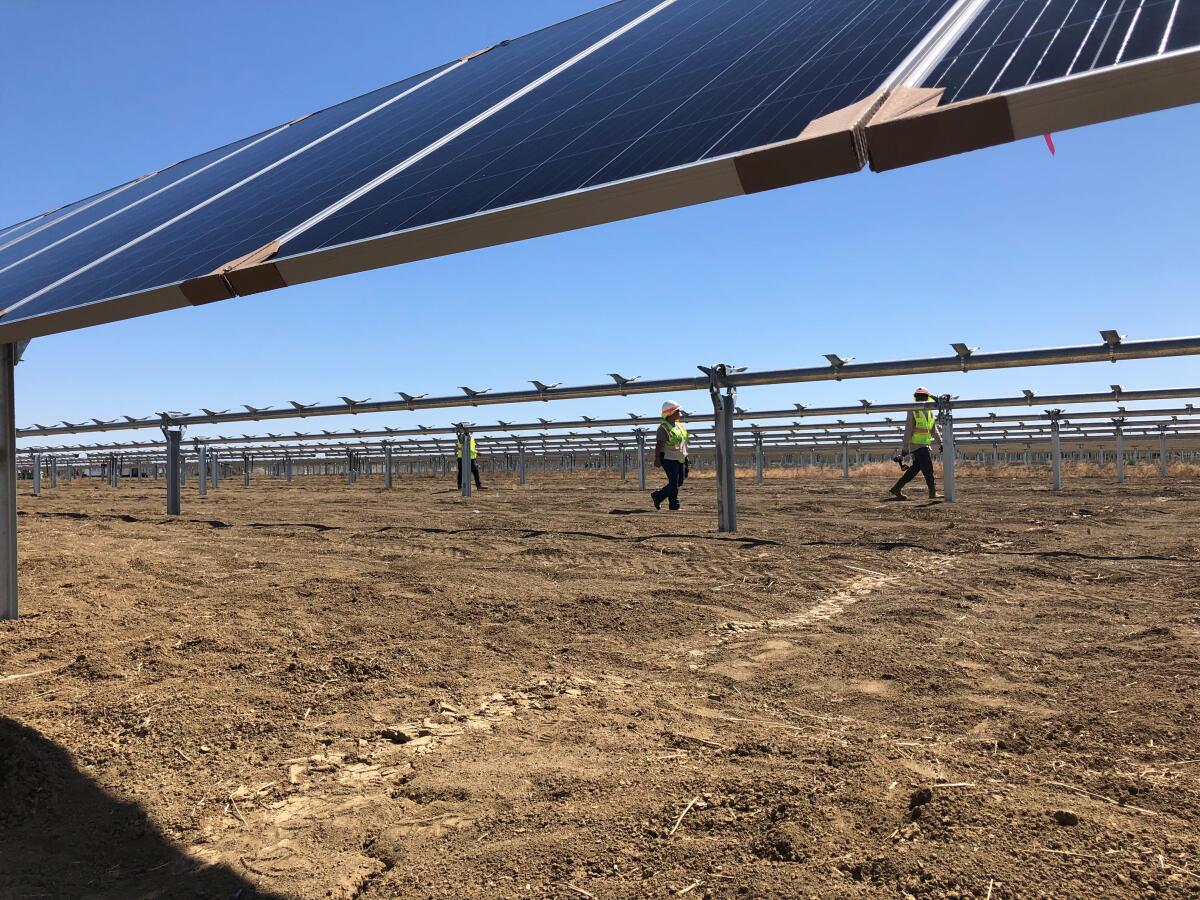
I’d never been to such a massive construction site before, but then again I don’t know of any other solar farms this big.
The project’s developer, Los Angeles-based real estate firm CIM Group, has permits to build 670 megawatts, which would be nearly 100 megawatts larger than the biggest U.S. solar farm operating today. The developer ultimately plans to install at least 2,700 megawatts by the end of the decade, across more than 20,000 acres — an area two-thirds the size of San Francisco.
CIM started building the first 250 megawatts last year and expects to finish this fall. Interestingly, the developer only has contracts in place for half that power — a sign they’re highly confident they’ll be able to find buyers for the rest at a profitable price.
“We decided to move forward knowing that the need is there,” CIM co-founder Avi Shemesh told me. “The need for power is tremendous, and the commitment (to clean energy), we believe, from the governmental agencies here is unequivocal.”
I sat down with Shemesh outside his company’s office on Wilshire Boulevard near Hancock Park, the week after touring the construction site. He told me CIM expects to spend “substantially north” of $4 billion to $5 billion building Westlands Solar Park.
That confidence was rewarded last month when the Public Utilities Commission ordered utilities and local governments to buy 11,500 megawatts of new, clean power by 2026. It’s a giant batch of energy designed to replace power plants retiring in the next few years, including the Diablo Canyon nuclear reactors and several gas generators along the Southern California coast.
Just adding a bunch of solar power won’t help much on scorching summer nights. But future phases of Westlands Solar Park — and most big solar farms from now on — will almost certainly include battery banks that can store a few hours’ worth of electricity for the evening. And as fossil fuels fade away, the state will need loads more climate-friendly power during the day, too.
“The needs in California are tremendous. And it’s not an issue of you need it tomorrow morning,” Shemesh said.
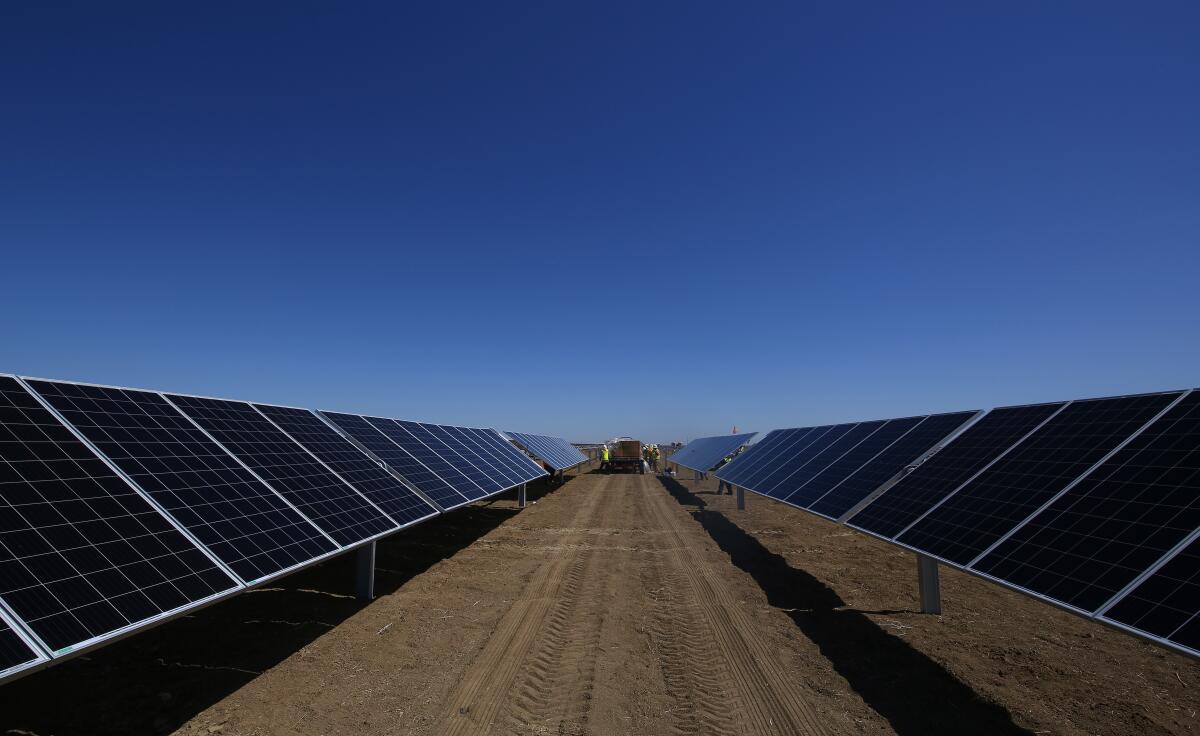
Another noteworthy facet of the solar project is the identities of the buyers, at least the ones that have signed up so far.
One is the city of Santa Clara, which agreed to buy 75 megawatts. The other is Valley Clean Energy, a government-run “community choice” agency, or CCA, that serves the cities of Davis, Winters and Woodland, and parts of unincorporated Yolo County.
Neither of those buyers is an investor-owned utility — you know, like Pacific Gas & Electric or Southern California Edison. As more local governments go the community choice route, the big utilities are increasingly being pushed out of the business of buying and selling electricity, prompting them to shift their focus to the poles and wires that move power around the state.
When a tidal wave of cities and counties started launching community choice programs a few years ago, skeptics were concerned they would be disruptive — and not in a good way. What if local governments didn’t have the financial wherewithal to withstand swings in energy markets? Would they be able to sign long-term contracts and get solar and wind farms built without long credit histories? What if they had to set electricity rates higher than expected, sending customers streaming back to the big utilities?
Thus far, those fears mostly have not come to pass. Severin Borenstein, an energy economist at UC Berkeley who worried early on that community choice could do more harm than good, now says the programs “are actually doing something useful” by providing competition in the energy marketplace. While he’s still concerned about the potential for bankruptcies — Western Community Energy in Riverside County became the first CCA to close its doors last month — he thinks the sector is in good shape.
“Now that this is a serious industry, they are starting to adopt serious industry practices,” Borenstein said.
For the Westlands Solar Park team, negotiating power sales with local governments has become a fact of life in California.
“We and our lenders are underwriting the specific risk of each CCA on its own. But we think they’re here to stay, with some exceptions,” Shemesh told me.
CIM’s solar project could also help California resolve one of its thorniest water challenges.
San Joaquin Valley farmers have been overpumping groundwater for decades, resulting in sinking land, buckling canals and household wells running dry, and threatening a future of severe water shortages, especially as climate change dries up rivers and snowpack. The situation is especially bad on “drainage-impaired” farmlands where the soil is loaded with crop-killing salts — and toxic selenium — because clay layers beneath the dirt prevent irrigation water from percolating into the underground aquifer.
The federal government has been fighting with Westlands Water District over the future of those troublesome lands for decades, ever since it was discovered that the original solution to the drainage problem — sending irrigation runoff to Kesterson National Wildlife Refuge east of San Jose — was killing ducks and other waterfowl and causing grotesque birth defects in birds.
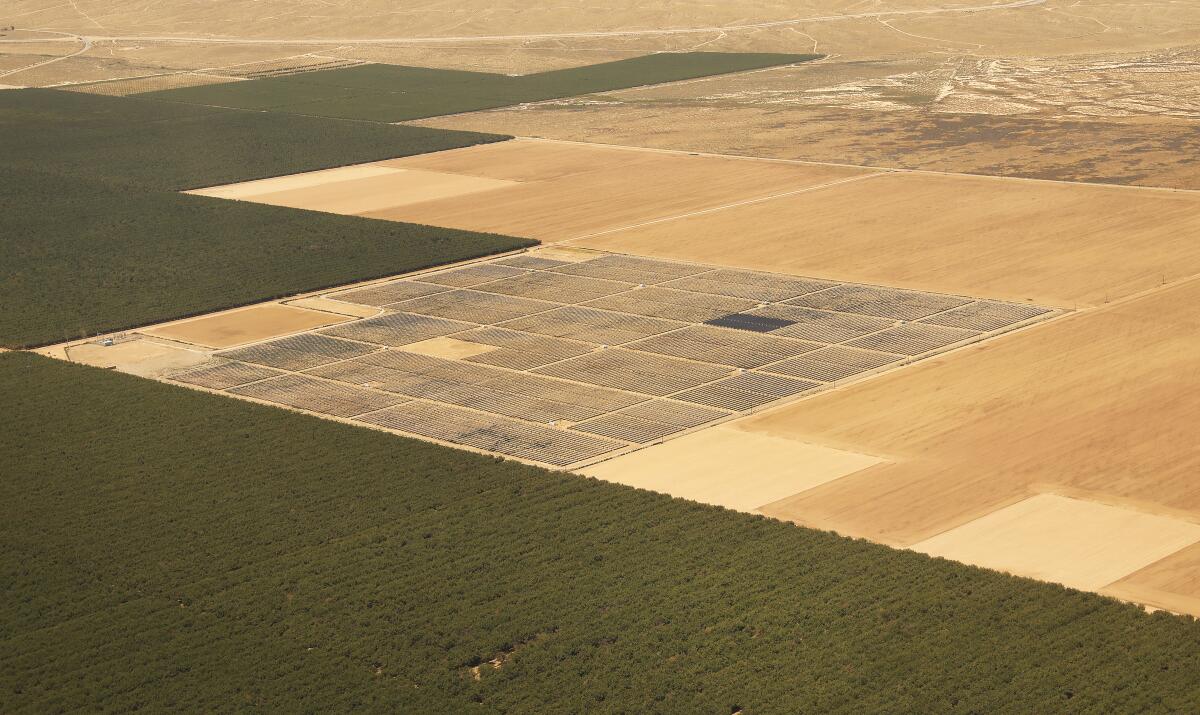
Solar offers at least a partial solution, giving Westlands Water District a good economic reason to take land out of agricultural production and not make the drainage problems worse. For CIM, the availability of so much land — without the environmental conflicts that have plagued renewable energy development elsewhere — helped to make the giant investment worthwhile.
“Being in a position of this scale, it just gives us a platform to really contribute to where the state is going in terms of decarbonization,” Shemesh said, referring to the process of drawing down planet-warming carbon emissions.
More broadly, experts say farmers may need to take more than half a million acres out of production in the San Joaquin Valley to comply with the Sustainable Groundwater Management Act. Solar could help replace some of the lost jobs and tax revenues.
The California grid operator estimates that about 2,000 additional megawatts are needed to limit the risk of rotating outages this summer. It’s yet to be seen whether power companies will step forward with that much energy. A lot may depend on circumstances elsewhere in the West. The recent unexpected shutdown of a unit at New Mexico’s San Juan coal plant, for instance, is the kind of event that could further limit California’s ability to import power from other states during the next big heat wave.
Longer term, California’s ability to keep the lights on — and the rest of the country’s willingness to follow its lead — will depend on an unprecedented infrastructure buildout, from giant projects like Westlands to lots more solar systems on rooftops. The alternative is a future of heat waves that will make the temperatures records of the last few weeks feel quaint.
Here’s what else is happening around the West:
TOP STORIES
Ammon Bundy is running for Idaho governor on a platform of taking over federal lands and building housing. Details here from my colleagues Anita Chabria and Hailey Branson-Potts, who report that Bundy is warning that dense cities — which experts say will be key to reducing emissions — destroy “conservative, traditional values.” Bundy is best known for his role in an armed confrontation with federal agents in Nevada, and for leading a takeover of an Oregon wildlife refuge. For a study in contrasts, the Washington Post reports that Senate Republicans are opposing Biden’s nominee to lead the Bureau of Land Management, Tracy Stone-Manning, calling her an extremist in part because she mailed a letter on behalf of anti-logging eco-saboteurs in college.
Hospitals in the Pacific Northwest were overwhelmed by patients during last week’s heat wave, with emergency room doctors saying they’d never seen anything like it. The Washington Post’s Sarah Kaplan wrote about what it was like inside a Portland hospital, and quoted a scientist describing the hot spell as “well beyond what climate models suggest.” As more people buy air conditioners to cope with rising temperatures, the New York Times’ Brad Plumer writes that some cities want them to consider electric heat pumps, which could help reduce the need for polluting gas furnaces by providing both cooling and heating.
A 200-foot-long, 165-foot-wide bridge over the 101 freeway — designed to create a safe crossing for cougars and other wildlife — would be the largest of its kind in the world. So writes The Times’ Louis Sahagún, describing an $87-million project that could help save local mountain lion populations by connecting habitats separated by highways. Down south, the San Diego Zoo is racing to save a rare butterfly threatened by climate change and fire, the San Diego Union-Tribune’s Jonathan Wosen writes.
DROUGHT AND FIRE

Over the rain year ending June 30, L.A. got just 5.82 inches — the seventh-driest total on record. “This is not climate change in the future. This is climate change right now,” oceanographer Bill Patzert told my colleagues Rachel Schnalzer and Lila Seidman. Conditions are even worse up north, where California’s largest reservoir, Lake Shasta, was at 38% of capacity last week; The Times’ Brian van der Brug took stunning drone photos showing how far the lake has fallen. And lest we forget that extreme heat isn’t helping with our water problems, Maddie Capron reports for the Sacramento Bee that Death Valley had its hottest June on record.
Firefighters thought they had stopped the Lava fire in its tracks. But the blaze may have kept smoldering in the root systems of trees embedded in ancient lava beds, aided by dry conditions; it eventually exploded into California’s largest wildfire this year, my colleague Alex Wigglesworth reports. Alex also talked with a man whose family had just 10 minutes to flee the Salt fire, only to learn the next day their home was gone. In British Columbia, more than 180 fires were burning, NPR’s Jeannette Muhammad reported, including one that forced the evacuation of the village that broke Canada’s all-time temperature record last week.
Latinos are twice as likely to live in the areas most threatened by fires, according to a new analysis. Politico’s Zack Colman reports that many of them have been pushed into dangerous areas by high housing costs elsewhere — another reminder that housing and climate are closely intertwined. In a tangentially related story, my colleague Matt Pearce wrote about the (extremely bad) L.A. tradition of Fourth of July fireworks setting palm trees on fire. In addition to date palms not being native to L.A. and not providing shade as the planet heats up, Matt notes that Latino tree trimmers frequently die pruning them, which I didn’t know.
THE ENERGY TRANSITION
A first-of-its-kind battery-powered train was just tested from Barstow to Stockton. The technology could (eventually) play a role in reducing climate pollution from freight and passenger rail, The Times’ Ralph Vartabedian reports. Orange County, meanwhile, is finally getting its first light rail system. It’s only four miles long and avoids upscale areas, my colleague Hannah Fry reports. But it’s still a big deal for a county that’s gone on a freeway-building binge and shunned rail in recent decades.
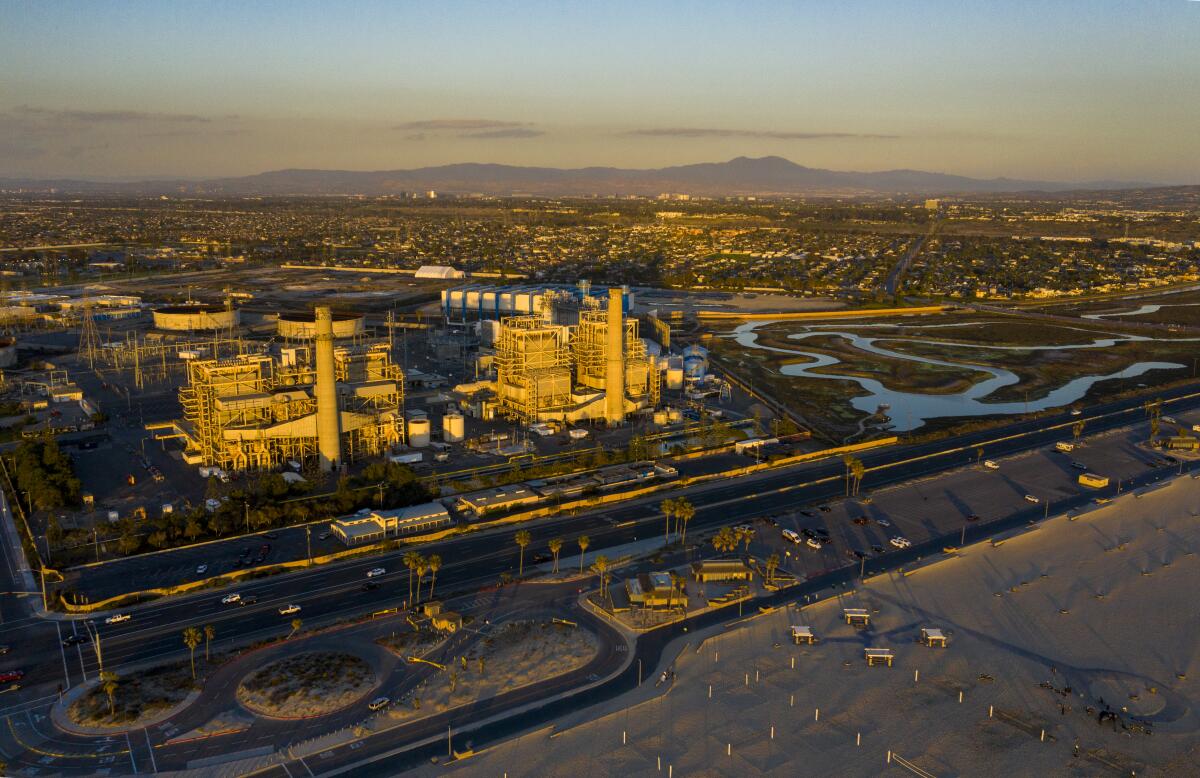
Three of the four coastal gas plants that California allowed to keep operating past 2020 — precisely so they could help keep the lights on during a heat wave — weren’t fully available during last month’s heat wave. Politico’s Colby Bermel had the scoop, reporting that several gas units were out of commission in Long Beach, Oxnard and Redondo Beach. (See my piece from April on efforts to shut down the Redondo Beach plant.) In related news, a 100-megawatt battery system just debuted in Oxnard after activists defeated plans for a new gas-fired power plant there, Wes Woods II reports for the Ventura County Star.
General Motors is making a multimillion-dollar investment in a proposed lithium and geothermal energy project near the Salton Sea. The Desert Sun’s Janet Wilson has the details on GM’s investment in Controlled Thermal Resources. This is a huge deal for the dream of a “Lithium Valley” in California’s Imperial County, which could fuel domestic battery production and give California a 24/7 clean energy source. For background, see my piece from March on the race for “white gold” at the Salton Sea.
POLITICAL CLIMATE
President Biden’s choice to lead the U.S. Forest Service is Randy Moore. He’ll be the first Black American to run the agency, which is the country’s second-largest landowner, and confronting wildfires will be one of his most important jobs, Paul Rogers reports for the Mercury News. Moore currently heads the Forest Service’s Pacific Southwest regional office out of Vallejo, Calif.
The National Park Service calls Mt. Rushmore a “shrine of democracy.” But some Indigenous activists say it should serve as a monument to the history of genocide against Native Americans, with one member of the Rosebud Sioux Tribe saying it should “be turned into something like the United States Holocaust Museum,” Annette McGivney writes for the Guardian. In another complex Indigenous issue out of the Dakotas, the people of the Fort Berthold reservation produce huge amounts of oil, complicating the Biden administration’s plans to limit fossil fuel extraction, Matthew Brown and Felicia Fonseca report for the Associated Press.
The budget passed by California lawmakers would restore electric vehicle rebates that critics say mostly go to higher-income people who don’t need them. Equity-focused EV incentives will get less funding, the San Francisco Chronicle’s Dustin Gardiner reports. Supporters of the rebates say they’ve played an important role in driving demand for cleaner vehicles.
ONE MORE THING

My colleague Leila Miller reported last month that 22 brown pelicans have been brought to a wildlife hospital in Orange County with severe wing fractures in recent months. Now she writes that the Animal Legal Defense Fund is offering a $5,000 reward for information on who might be responsible. It’s a disturbing story, to say the least. If you know something, say something.
We’ll be back in your inbox next week. If you enjoyed this newsletter, please consider forwarding it to your friends and colleagues.



